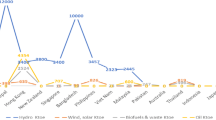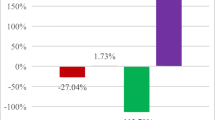Abstract
Recovery energy has been one of important components of energy consumption structure in China. Recovery energy is a type of secondary energy, which is generated from various sources. Since the estimation of recovery energy from some sources such as coke oven gas and other coal gas contains some uncertainties, recovery energy can be represented as an interval variable. The extant studies in the literature ignore recovery energy in the evaluation of energy efficiency or carbon dioxide (\(\text {CO}_{2}\)) emissions efficiency. As a part of energy supply in China, recovery energy may influence regional primary energy consumption and \(\text {CO}_{2}\) emissions significantly. In this context, this paper proposes an interval slacks-based measure approach to evaluate energy efficiency and \(\text {CO}_{2}\) emissions efficiency in the presence of recovery energy in China. In the described approach, the indicator of \(\text {CO}_{2}\) emissions is incorporated based on the weak disposability assumption, and recovery energy is modeled as a dual factor. The optimal exact data on recovery energy of each region can be obtained. Based on the proposed approach, the measures of energy saving potential and \(\text {CO}_{2}\) emissions reduction potential are derived. Findings resulting from the model application show that there are great disparities in regional efficiencies, and the inefficiency of Chinese regions is largely driven by those inefficient regions in the central and western areas. Notably, the development of recovery energy can help to improve regional energy efficiency and \(\text {CO}_{2}\) emissions efficiency in China.






Similar content being viewed by others
References
Al-Mansour, F. (2011). Energy efficiency trends and policy in Slovenia. Energy, 36(4), 1868–1877.
Ang, B. W. (2006). Monitoring changes in economy-wide energy efficiency: From energy-GDP ratio to composite efficiency index. Energy Policy, 34, 574–582.
Azadi, M., & Saen, R. F. (2011). A new chance-constrained data envelopment analysis for selecting third-party reverse logistics providers in the existence of dual-role factors. Expert Systems with Applications, 38(10), 12231–12236.
Bi, G., Song, W., Zhou, P., & Liang, L. (2014). Does environmental regulation affect energy efficiency in China’s thermal power generation? Empirical evidence from a slacks-based DEA model. Energy Policy, 66, 537–546.
Bi, G., Luo, Y., Ding, J., & Liang, L. (2015). Environmental performance analysis of Chinese industry from a slacks-based perspective. Annals of Operations Research, 228(1), 65–80.
Bian, Y., He, P., & Xu, H. (2013). Estimation of potential energy saving and carbon dioxide emission reduction in China based on an extended non-radial DEA approach. Energy Policy, 63, 962–971.
Chang, Y., Park, H., Jeong, J., & Lee, J. (2014). Evaluating economic and environmental efficiency of global airlines: A SBM-DEA approach. Transportation Research Part D, 27, 46–50.
Chen, Y., Cook, W. D., Du, J., Hu, H., & Zhu, J. (2015). Bounded and discrete data and Likert scales in data envelopment analysis: application to regional energy efficiency in China. Annals of Operations Research,. doi:10.1007/s10479-015-1827-3.
Choi, Y., Zhang, N., & Zhou, P. (2012). Efficiency and abatement costs of energy-related CO\(_{2}\) emissions in China: A slacks-based efficiency measure. Applied Energy, 98, 198–208.
Cook, W. D., Green, R. H., & Zhu, J. (2006). Dual-role factors in data envelopment analysis. IIE Transactions, 38(2), 105–115.
Cook, W. D., & Zhu, J. (2007). Classifying inputs and outputs in data envelopment analysis. European Journal of Operational Research, 180, 692–699.
Cooper, W. W., Park, K. S., & Yu, G. (1999). IDEA and AR-IDEA: Models for dealing with imprecise data in DEA. Management Science, 45, 597–607.
Dai, Y., Zhu, Y., Bai, Q., Hu, X., & Yu, S. (2009). Chin’s low carbon development pathways by 2050. Beijing: Science Press.
Despotis, D. K., & Smirlis, Y. G. (2002). Data envelopment analysis with imprecise data. European Journal of Operational Research, 140(1), 24–36.
Entani, T., Maeda, Y., & Tanaka, H. (2002). Dual models of interval DEA and its extension to interval data. European Journal of Operational Research, 136(1), 32–45.
Fare, R., & Grosskopf, S. (2004). Modeling undesirable factors in efficiency evaluation: Comment. European Journal of Operational Research, 157, 242–245.
Fukuyama, H., & Weber, W. L. (2009). A directional slacks-based measure of technical inefficiency. Socio-Economic Planning Sciences, 43, 274–287.
Gabriel-Buenaventura, A., & Azzopardi, B. (2015). Energy recovery systems for retrofitting in internal combustion engine vehicles: A review of techniques. Renewable and Sustainable Energy Reviews, 41, 955–964.
Guo, X., Zhu, L., Fan, Y., & Xie, B. (2011). Evaluation of potential reductions in carbon emissions in Chinese provinces based on environmental DEA. Energy Policy, 39, 2352–2360.
Hernández-Sancho, F., Molinos-Senante, M., & Sala-Garrido, R. (2011). Energy efficiency in Spanish wastewater treatment plants: a non-radial DEA approach. Science of The Total Environment, 409, 2693–2699.
Hu, J. L., & Kao, C. H. (2007). Efficient energy-savings targets for APEC economics. Energy Policy, 35, 373–382.
Hu, J. L., & Wang, S. C. (2006). Total-factor energy efficiency of regions in China. Energy Policy, 34, 3206–3217.
Hu, J., Wang, S., & Yeh, F. (2006). Total-factor water efficiency of regions in China. Resource Policy, 31, 217–230.
Hua, Z. S., Bian, Y. W., & Liang, L. (2007). Eco-efficiency analysis of paper mills along the Huai River: An extended DEA approach. Omega, 35, 578–587.
Hou, J., Zhang, P., Tian, Y., Yuan, X., & Yang, Y. (2011). Developing low-carbon economy: Actions, challenges and solutions for energy saving in China. Renewable Energy, 36, 3037–3042.
Jiang, B., Sun, Z., & Liu, M. (2010). China’s energy development strategy under the low carbon economy. Energy, 35, 4257–4264.
Khalili-Damghani, K., Tavana, M., & Haji-Saami, E. (2015). A data envelopment analysis model with interval data and undesirable output for combined cycle power plant performance assessment. Expert Systems with Applications, 42, 760–773.
Lee, M., & Zhang, N. (2012). Technical efficiency, shadow price of carbon dioxide emissions, and substitutability for energy in the Chinese manufacturing industries. Energy Economics, 34, 1492–1497.
Li, H., Mu, H., Zhang, M., & Gui, S. (2012). Analysis of regional difference on impact factors of China’s energy-Related CO\(_{2}\) emissions. Energy, 39, 319–326.
Li, Y., & Oberheitmann, A. (2009). Challenges of rapid economic growth in China: Reconciling sustainable energy use, environmental stewardship and social development. Energy Policy, 37, 1412–1422.
Lozano, S., & Gutiérrez, E. (2008). Non-parametric frontier approach to modelling the relationships among population, GDP, energy consumption and CO\(_{2}\) emissions. Ecological Economics, 66, 687–699.
Lozano, S., Gutiérrez, E., & Moreno, P. (2013). Network DEA approach to airports performance assessment considering undesirable outputs. Applied Mathematical Modelling, 37, 1665–1676.
Lv, W., Hong, X., & Fang, K. (2015). Chinese regional energy efficiency change and its determinants analysis: Malmquist index and Tobit model. Annals of Operations Research, 228(1), 9–22.
Nixon, J. D., Dey, P. K., Ghosh, S. K., & Davies, P. A. (2013). Evaluation of options for energy recovery from municipal solid waste in India using the hierarchical analytical network process. Energy, 59, 215–223.
Olivier, J.G.J., Janssens Maenhout, G., & Peters, J.A.H.W. (2012). Trends in global CO\(_{2}\) emissions 2012 report. The Hague: PBL Netherlands Environmental Assessment Agency; Ispra: Joint Research Centre. http://www.pbl.nl/en/publications/2012/trends-in-global-co2-emissions-2012-report.
Rao, X., Wu, J., Zhang, Z., & Liu, B. (2012). Energy efficiency and energy saving potential in China: Analysis based on slacks-based measure model. Computers & Industrial Engineering, 63, 578–584.
Schneider, D. R., Kirac, M., & Hublin, A. (2012). Cost-effectiveness of GHG emission reduction measures and energy recovery from municipal waste in Croatia. Energy, 48, 203–211.
Shan, H. (2008). Re-estimating the capital stock of China: 1952–2006. Journal of Quantitative and Technical Economics, 10, 17–31. (in Chinese).
Tone, K. (2001). A slacks-based measure of efficiency in data envelopment analysis. European Journal of Operational Research, 130(3), 498–509.
Wang, K., & Wei, Y. (2014). China’s regional industrial energy efficiency and carbon emissions abatement costs. Applied Energy, 130, 617–631.
Wang, K., Wei, Y., & Zhang, X. (2012). A comparative analysis of China’s regional energy and emission performance: Which is the better way to deal with undesirable outputs? Energy Policy, 46, 574–584.
Wang, K., Zhang, X., Wei, Y., & Yu, S. (2013). Regional allocation of CO\(_{2}\) emissions allowance over provinces in China by 2020. Energy Policy, 54, 214–229.
Wei, Y., Jiao, H., & Fan, Y. (2007). An empirical analysis of energy efficiency in China’s iron and steel sector. Energy, 32, 2262–2270.
Wei, C., Ni, J., & Du, L. (2012). Regional allocation of carbon dioxide abatement in China. China Economic Review, 23, 552–565.
Wu, F., Fan, L. W., Zhou, P., & Zhou, D. Q. (2012). Industrial energy efficiency with CO\(_{2}\) emissions in China: A nonparametric analysis. Energy Policy, 49, 164–172.
Zhang, X., Cheng, X., Yuan, J., & Gao, X. (2011). Total-factor energy efficiency in developing countries. Energy Policy, 39, 644–650.
Zhou, P., & Ang, B. W. (2008). Linear programming models for measuring economy-wide energy efficiency performance. Energy Policy, 36, 2911–2916.
Zhou, P., Ang, B. W., & Poh, K. L. (2008). A survey of data envelopment analysis in energy and environmental studies. European Journal of Operational Research, 189(1), 1–18.
Zhou, P., Ang, B. W., & Poh, K. L. (2006). Slacks-based efficiency measures for modeling environmental performance. Ecological Economics, 60(1), 111–118.
Zhu, J. (2003). Imprecise data envelopment analysis (IDEA): A review and improvement with an application. European Journal of Operational Research, 144(3), 513–529.
Acknowledgments
The corresponding author (Anyu Yu) on behalf of all authors would like to thank the editor and three anonymous reviewers for their helpful comments and suggestions. This research is partly supported by the grant of Humanities and Social Sciences of Chinese Ministry of Education (No.10YJC630007). Professor Kangjuan Lyu (Lv) thanks the support by 2013 Shanghai Municipal Philosophy and Social Science fund (no. 2013BCK002). Dr. Bian thanks the support by NSFC grants (Nos.71101085 and 71571115) and NSFC major international (regional) joint research program (No.71320107004).
Author information
Authors and Affiliations
Corresponding author
Rights and permissions
About this article
Cite this article
Bian, Y., Lv, K. & Yu, A. China’s regional energy and carbon dioxide emissions efficiency evaluation with the presence of recovery energy: an interval slacks-based measure approach. Ann Oper Res 255, 301–321 (2017). https://doi.org/10.1007/s10479-015-2027-x
Published:
Issue Date:
DOI: https://doi.org/10.1007/s10479-015-2027-x




